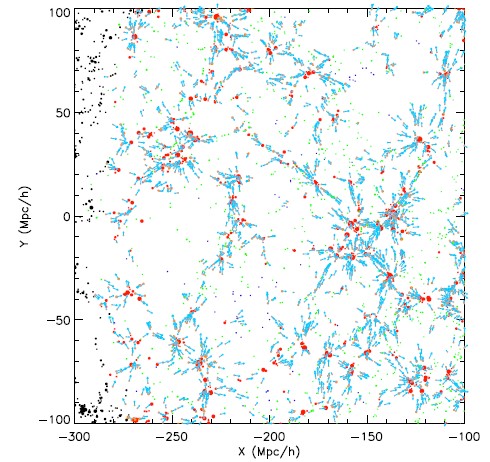In the current universe, large scale environments are mainly consists of these four types: clusters, filaments, sheets and voids. According to the current paradigm of galaxy formation, these structures arise from the linear growth of density fluctuations in a nearly homogeneous universe at the early epoch. Dark matter tends to flow out of the voids, accretes onto the sheets, collapses to the filaments, and finally accumulates onto the clusters at the intersection of filaments. Due to the accretion history of the universe, the angular momentum of dark matter halos and galaxies are generated and affected by their large-scale environments.
For halos in filaments from high-resolution simulations, recent studies have reported that the spins of low-mass halos tend to be parallel to filaments, while high-mass halos tend to orthogonal to filaments. For halos in sheets, the spins tend to lie in the plane of the sheets, independent of halo mass.
While in observations, this picture is not clear due to limited statistics and the difficulty of properly defining cosmic filaments from observations. There is no certain result about this problem.
In order to solve this problem, Dr. Zhang Youcai from Shanghai Astronomical Observatory (SHAO) and his colleagues have endeavored to tackle it based on observations and simulations for a number of years. A series of papers have been published in the Astrpophysical Journal.
In their recent work [Zhang et al 2015, ApJ, 798, 17], they have investigated the alignment of spin axes of spiral galaxies with their surrounding large-scale structure, using a sample of spiral galaxies selected from the Sloan Digital Sky Survey Date Release 7 and Galaxy Zoo 2. They have found that the spin axes only have weak tendencies to be aligned with (or perpendicular to) the intermediate (or minor) axis of the local tidal tensor. Compared to the alignments between halo spins and the local tidal field obtained in N-body simulations, this observational result is well agreed with those for the spins of inner regions of halos, suggesting that the disk material traces the angular momentum of dark matter halos in the inner regions.
New results suggest that the shape of galaxies are aligned with each other over scales comparable to those of sheets and filaments in the cosmic web, and the spin axes of galaxies ( in particular for galaxies in clusters) tend to be parallel to the intermediate axes of the local tidal tensor. Such alignments have important ramifications for cosmic shear measurements based on the orientation correlation of source galaxies.

Galaxy distributions and environmental classifications in a slice of thickness (10 h-1 Mpc) from SDSS DR7. The galaxy groups in four different environments are classified by different colors: clusters (red), filaments (orange), sheets (green) and voids (blue). The cyan arrow indicators the direction of the filaments at the center of each group. Refer to these papers [Zhang et al 2013, ApJ, 779, 160; Zhang et al 2015, ApJ, 798, 17] for more details.
Link to the scientific paper: http://iopscience.iop.org/0004-637X/798/1/17